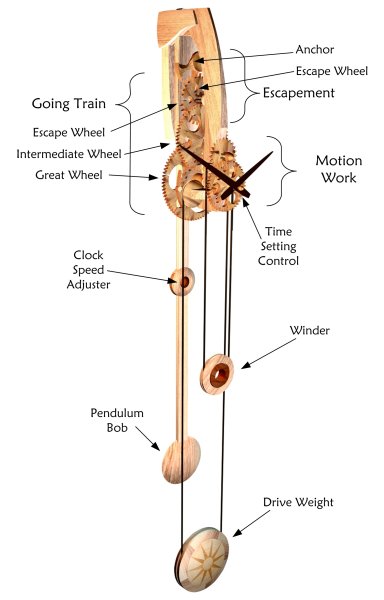
These are weight driven, pendulum regulated clocks. They work in the traditional manner, so the following describes many simple (ie non-chiming) clocks from the last few centuries.
The drive weight pulls on a cord which connects with the great wheel, causing it to rotate clockwise. This wheel meshes with the small pinion on the intermediate wheel, it rotates faster but anticlockwise. This wheel in turn meshes with the escape wheel pinion, this reverses the direction again and goes faster still. These three wheels are together known as the Going Train. If the escape wheel were allowed to freely rotate the wheels would spin very fast and the drive weight would descend fully in less than a minute.
Mounted to the rear of the clock is a pendulum, swinging with a very regular and predictable beat. The clocks escapement (the combination of the uppermost wheel and the rocking anchor) connects the pendulum to the going train - the speed of rotation of the escape wheel is now precisely controlled by the swing of the pendulum. The gearing ratios and pendulum length are arranged so that the great wheel revolves once an hour.
The great wheel is mounted on a shaft (the main arbour) - the clocks minute hand is fixed to it's far end. The set of three gears mounted to the front of the clock (called the 'motion work') causes the hour hand to be pulled round at 1/12th of the speed of the main arbour. There is a frictional clutch built into one of the motion work wheels - if the time setting control is pushed inwards, the motion work is disengaged from the main arbour allowing the hands to be turned freely and the correct time to be set (the page 'Timekeeping' shows this graphically).
The escapement does two jobs at the same time: as well as regulating the speed of the going train it also delivers power to the pendulum to keep it swinging. Each time an escape wheel tooth is released a little push is given to the anchor - first in one direction, then the other; these impulses are just enough to overcome frictional losses and keep the pendulum swinging.
These clocks run for thirty hours when fully wound - they need to be wound daily (though not necessarily at the same time each day). The clock is wound by placing a thumb in the central hole of the winder and pulling down - the drive weight is lifted until it is stopped by the underside of the clock frame. A ratchet allows the weights to move freely in this direction, power is restored to the clock when the counterweight is released. This design does not use a 'maintaining power' arrangement, so the pendulum swings freely and the clock movement reverses for the few seconds of winding.
There are no hidden motors or batteries - the power that drives the clock came from the arm muscles of the person who last wound it.





